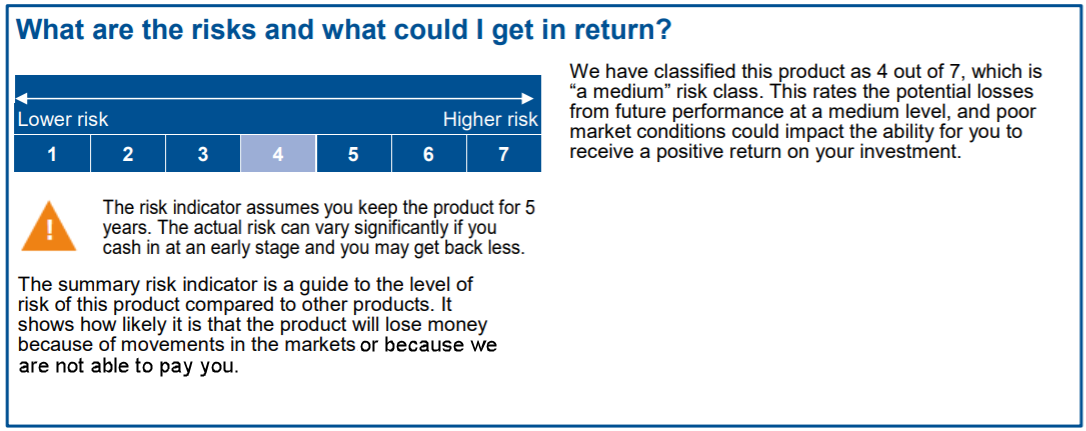| Currency Risk | If the product is denominated in a currency other than that of the member state being marketed to then a currency warning is required. | “Be aware of currency risk. You will receive payments in a different currency, so the final return you will get depends on the exchange rate between the two currencies. This risk is not considered in the indicator shown above.”
(above wording is mandatory if disclosure conditions are met) |
| Illiquidity Risk Possible Disclosure 1 ^ | To be used if product does not offer early exit or redemption possibilities prior to maturity. | “You cannot cash in early”
(above wording is mandatory if disclosure conditions are met) |
| Illiquidity Risk Possible Disclosure 2 ^ | To be used if a market for the product may not exist. | “You may not be able to cash in early.”
(above wording is mandatory if disclosure conditions are met) |
| Illiquidity Risk Possible Disclosure 3 ^ | To be used if product has option to cash in early but will incur significant costs to do so. | “You will have to pay significant extra costs to cash in early.”
(above wording is mandatory if disclosure conditions are met) |
| Illiquidity Risk Possible Disclosure 4 ^ | To be used if market for product may not exist and liquidity provided by manufacturer will incur significant costs. | “You may have to pay significant extra costs to cash in early.”
(above wording is mandatory if disclosure conditions are met) |
| Material Liquidity Risk ^ | To be used if the product is regarded as having a material liquidity risk. The following scenarios apply:
1. If the product has a secondary or alternative market without committed liquidity so the ability to sell is only dependent upon buyers, irrespective of whether there is good liquidity at present.
2. Where manufacturer estimates that whatever reason the investor may find it difficult in terms of time and/or costs to disinvest. | “You may not be able to sell your product easily or you may have to sell at a price that significantly impacts on how much you get back.”
(above wording is mandatory if disclosure conditions are met) |
| Other Risks | In theory fully optional but difficult to argue that no other risks. In practice most manufacturers include a “please refer to Prospectus for details list of risks.” type statement. | 200 character limit to explain other risks materially relevant to the product. In practice, a “Please refer to the Prospectus for a detailed list of risks.” disclosure is made here. (Free text.) |
| Existing Capital Protection ^^ | To be used where the product has capital protection (partial or full) against market risk. | “You are entitled to receive back at least [insert %] of your capital. Any amount over this, and any additional return, depends on future market performance and is uncertain. “
(above wording is mandatory if disclosure conditions are met) |
| Where no Capital Protection ^^ | To be use where the product has no capital protection. | “This product does not include any protection from future market performance so you could lose some or all of your investment.” |
| Early exit limitations to Capital Protection ^^^ | To be used in addition to “Existing Capital Protection” Disclosure above where early exit conditions apply which may limit the capital protection. | “However, this protection against future market performance will not apply if you cash-in before [… years/months/days]”
(above wording is mandatory if disclosure conditions are met) |
| Where future payments required to avail of Capital Protection ^^^ | To be used in addition to “Existing Capital Protection” Disclosure above where ongoing payments must be made to continue to avail of the capital protection. | “However, this protection against future market performance will not apply if you fail to make your payments in time.”
(above wording is mandatory if disclosure conditions are met) |
| Other limitations to Capital Protection ^^^ | To be used in addition to “Existing Capital Protection” Disclosure above where other limitations apply to the ability to avail of the capital protection. | “However, this protection against future market performance will not apply if you (Free Text)”
(above wording is mandatory if disclosure conditions are met, subject to free text portion) |
| Absence of guarantee against credit risk | To be used where the product holds no capital guarantee against credit risk. | “If we are not able to pay you what is owed, you could lose your entire investment.”
(above wording is mandatory if disclosure conditions are met) |
| Limitations of credit risk guarantees | To be used where the product holds a capital guarantee against credit risk but there are limitations re same. | “However, you may benefit from a consumer protection scheme (see the section ‘what happens if we are unable to pay you’). The indicator shown above does not consider this protection.”
(above wording is mandatory if disclosure conditions are met) |

